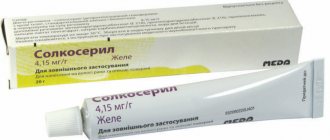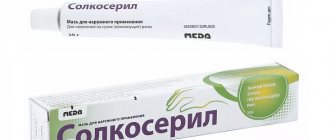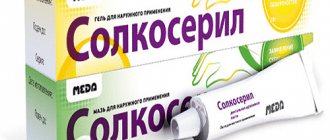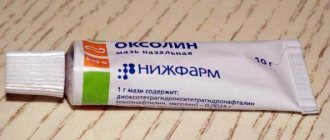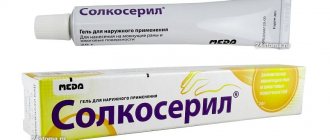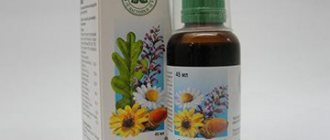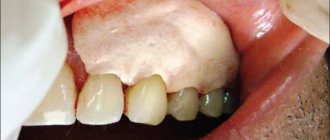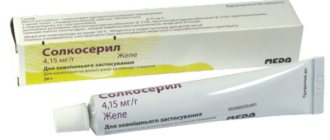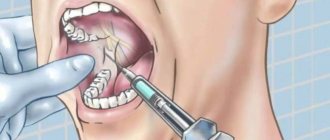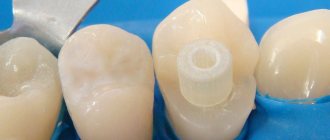The uniqueness of the composition of solcoseryl
The ointment has a uniform, greasy texture; the color can vary from deep white to yellow, with a characteristic odor of broth and petroleum jelly.
The active components of solcoseryl include deproteinized (removal of proteins) hemoderivat from the blood of 3-month-old calves at a concentration of 2.07 mg/g. Auxiliary components are represented by methyl parahydroxybenzoate and propyl parahydroxybenzoate (preservatives), palmitic alcohol (emulsifier), white petrolatum (ointment base), water for injection (dissolution of dry dialysate).
An analogue of the drug is Actovegin ointment. These drugs appeared on the pharmaceutical market almost simultaneously and differ only in the manufacturer and price.
The main active ingredient of solcoseryl is a deproteinized hemoderivat, which is obtained by dialysis and subsequent ultrafiltration. During the production process, high molecular weight proteins are removed (deproteinization). This is a complex compound that includes natural low-molecular substances with a molecular weight of up to 5000 Da.
Such a unique composition cannot be reproduced in laboratory conditions. Basically, these are electrolytes, amino acids, nucleotides, nucleosides. The effectiveness of only some of these substances has been described and proven from a pharmacological point of view. However, in vitro tests have proven the effectiveness of solcoseryl in the treatment of damaged tissues and wound surfaces.
Composition of the drug and form of manufacture
This medicine is sold in the form of aluminum tubes of 5 grams each, which are packaged in separate cardboard boxes.
The drug itself is a homogeneous mass that has a light orange color and has a rich mint smell. The homogeneity of solcoseryl gel allows it to be evenly applied over the surface of the wound. The composition of solcoseryl ointment includes the following elements:
- dialysate from the blood of a young calf in which there are no proteins.
Antigens are extracted from the blood using special chemical and biological treatment. This element is the main active substance of the drug;
- relieve pain (polidocanol);
- peppermint oil/menthol (auxiliary elements);
- components taken as the basis for solcoseryl ointment (pectin, liquid paraffin, gelatin, etc.);
- preservative substances (parahydroxybenzoate, pilparahydroxybenzoate);
Pharmacological action of the ointment
The pharmacological properties of the drug have not been fully studied. However, during the studies it was proven that solcoseryl has the following properties:
- in case of oxygen deficiency, its delivery to damaged cells is ensured;
- glucose transfer in metabolic disorders;
- is a catalyst for the formation of intracellular ATP;
- ensures the storage of energy in mitochondria generated during the transformation of nutrients;
- supports cells during nutritional deficiencies by supplying high-energy phosphates;
- prevents or prevents atypical changes with minor cell damage;
- “launches” the process of natural restoration of cells and tissues;
- activates the proliferation (division and formation) of fibroblasts that form the framework of connective fibers, and the formation of collagen filaments in the walls of blood vessels.
The ointment is widely used in cosmetology, gynecology, ophthalmology, and dentistry.
Main indications for use of the product
Ointment with solcoseryl is recommended for:
- minor skin damage in the form of abrasions;
- burns (except chemical) 1-2nd degree, which occur without the formation of exudate;
- frostbite of the 1st-2nd degree in the absence of wound weeping;
- psoriasis;
- to eliminate dry calluses and corns;
- to prevent the formation of scars after laser removal of warts or moles;
- atopic and seborrheic dermatitis;
- “sticking” in the corners of the mouth;
- drying of the nasal mucosa;
- in the treatment of wounds that heal poorly, including trophic ulcers and bedsores, after removal of dead tissue.
As a rule, a gel with solcoseryl is first applied to treat the wound surface with the separation of exudate. After the first signs of wound granulation appear, therapy is continued with the drug in the form of an ointment.
Differences between the ointment form of solcoseryl and the gel form
Pharmacies offer 2 forms of the drug intended for external local use. How do they differ and is it necessary to pay attention to such nuances?
The main differences between the forms are due to the excipients. Thus, solcoseryl gel does not contain fatty bases, which is why it is quickly washed off with warm water and removed from the surface of the skin. Due to this, it is the gel form that stimulates the formation of granulation tissue and the elimination of wound exudate.
When the wound dries out and signs of granulation appear, it would be more appropriate to use ointment. The fatty base of the drug forms a protective film on the surface of the wound, so the healing process is noticeably faster. In addition, solcoseryl ointment softens the surface of the wound, thereby avoiding the appearance of scars and other skin defects.
How to use the ointment
Instructions for use of solcoseryl include the following recommendations:
- the ointment is applied only topically directly to the wound, covering those areas where the healing process has begun;
- the wound surface is pre-cleaned with disinfectant solutions, since the ointment does not contain antibacterial components;
- in case of purulent infection, cleanse from exudate and dead tissue;
- ointment is prescribed for the treatment of injuries with clear signs of healing;
- apply solcoseryl to the surface of the wound in the morning and evening, apply a bandage if necessary;
- Treatment should be continued until the wound is completely scarred.
The use of solcoseryl is determined by the type of pathology. Thus, for chronic trophic ulcers, it is recommended to treat the inner surface with solcoseryl gel, and the outer edges of the wound with ointment 2 times a day for 3 weeks. For diabetic feet without exudate, the ointment is applied twice a day for 2 months.
In proctology, solcoseryl ointment has only positive reviews from patients. This is due to the fact that the drug promotes rapid tissue healing and stimulates blood supply in damaged vessels. However, the ointment can be used only for external forms of hemorrhoids, which are not accompanied by the formation of anal fissures (in this case, it is more appropriate to prescribe solcoseryl gel). The drug is applied to hemorrhoids 4-5 times a day for a week.
The nuances of using the ointment:
- The drug should not be used by pregnant women or during lactation, since appropriate clinical trials have not been conducted;
- if pain appears in the wound area, redness of the skin around the injury, exudate, or elevated body temperature, you should consult your doctor;
- If there are no signs of wound healing within 2-3 weeks of use, you should immediately consult a doctor, as this may indicate a benign or malignant wound process.
Solcoseryl (gel), 1 pc., 20 g, gel for external use
Solcoseryl injection solution:
IV
or
IM
.
In the treatment of occlusive diseases of peripheral arteries in stages III–IV according to Fontaine
- IV 20 ml daily. Intravenous drip administration in isotonic sodium chloride solution or 5% glucose solution is possible. The duration of therapy is up to 4 weeks and is determined by the clinical picture of the disease.
In the treatment of chronic venous insufficiency accompanied by trophic disorders (Ulcera cruris)
- IV 10 ml 3 times a week. The duration of therapy is no more than 4 weeks and is determined by the clinical picture of the disease. An important additional measure aimed at preventing peripheral “venous” edema is the application of a pressure bandage using an elastic bandage.
In the presence of local trophic tissue disorders, simultaneous therapy with Solcoseryl jelly and then Solcoseryl ointment is recommended.
In the treatment of ischemic and hemorrhagic strokes in severe and extremely severe forms
as the main course - 10 or 20 ml intravenously, respectively, daily for 10 days. Upon completion of the main course - 2 ml intramuscularly or intravenously for 30 days.
Traumatic brain injury (severe brain contusion)
- IV 1000 mg, daily for 5 days.
If intravenous administration of the drug is not possible, the drug can be administered intramuscularly, usually 2 ml per day undiluted.
When using the undiluted drug intravenously, it must be administered slowly, since it is a hypertonic solution.
Solcoseryl gel, ointment:
topically.
Apply directly to the wound surface after preliminary cleansing of the wound using a disinfectant solution.
Before starting treatment of trophic ulcers, as well as in cases of purulent infection of the wound, preliminary surgical treatment is necessary.
Solcoseryl gel is applied to fresh wounds, wounds with wet discharge, and to ulcers with signs of weeping - a thin layer on a cleaned wound 2-3 times a day. It is recommended to lubricate areas where epithelization has begun with Solcoseryl ointment. The use of Solcoseryl gel continues until pronounced granulation tissue forms on the damaged skin surface and the wound dries out.
Solcoseryl ointment is used primarily for the treatment of dry (non-wetting) wounds.
Solcoseryl ointment is applied in a thin layer to a cleaned wound 1-2 times a day; it can be used under bandages. The course of treatment with Solcoseryl ointment continues until the wound is completely healed, its epithelization and the formation of elastic scar tissue.
For the treatment of severe trophic damage to the skin and soft tissues, the simultaneous use of parenteral forms of Solcoseryl is recommended.
Possible side effects and contraindications
Very rarely, urticaria, itching, redness, and marginal dermatitis appear at the site of application of solcoseryl. If such allergic reactions occur, it is recommended to stop using the ointment and consult a doctor to change the drug.
Solcoseryl is contraindicated in case of hypersensitivity to the components of the ointment. It is also recommended to use it with caution in patients prone to allergies.
Solcoseryl in cosmetology: effective fight against wrinkles
Women appreciated the effect of the drug on the condition of the skin, although the instructions do not contain instructions for using solcoseryl for the face. Based on it, recipes for many masks have been created that effectively even out skin tone, promote the healing of microtraumas, and solcoseryl also helps get rid of wrinkles.
Cosmetologists explain the effectiveness of solcoseryl as a cosmetic product by the pharmacological action of the drug. Stimulating metabolism in cells, collagen synthesis and activating tissue repair make it possible to use solcoseryl to combat wrinkles.
However, there are no studies that would confirm its effectiveness, which does not prevent the drug from being used in beauty salons and at home as part of a variety of face masks. Women consider the safety and low cost of procedures to be the indisputable advantage of cosmetics with the addition of solcoseryl.
Cosmetologists claim that solcoseryl ointment moisturizes and nourishes the skin, promotes the healing of small cracks and saturates cells with oxygen. The ointment is mixed with nourishing cream in a 1:1 ratio and the mixture is applied to the facial skin twice a week at night. Solcoseryl can be used undiluted as a face mask. The ointment is applied to the skin for 1.5 hours, after which it is washed off with warm water.
The ointment is especially effective as a lip balm. To do this, solcoseryl is mixed with your favorite balm and applied to the skin of the lips. This product helps to quickly restore damaged skin.
Indications for use of solcoseryl ointment (instructions for use)
The paste will be effective for use by people of any age group.
The practical use of solcoseryl ointment should be carried out when the following diseases are identified:
- gingivitis and stomatitis;
- pemphigus and alveolitis;
- periodontal disease.
Mechanical damage to the oral cavity can also result from the use of solcoseryl gel:
- deformations of the soft tissues of the gums, wounds (cracks) of the lips;
- jaw fractures;
- injuries resulting from operations in the oral cavity;
- bedsores under fillings and dentures.
Contraindications to the use of the drug are very difficult to predict, since any of the elements included in its composition can cause an allergic reaction.
